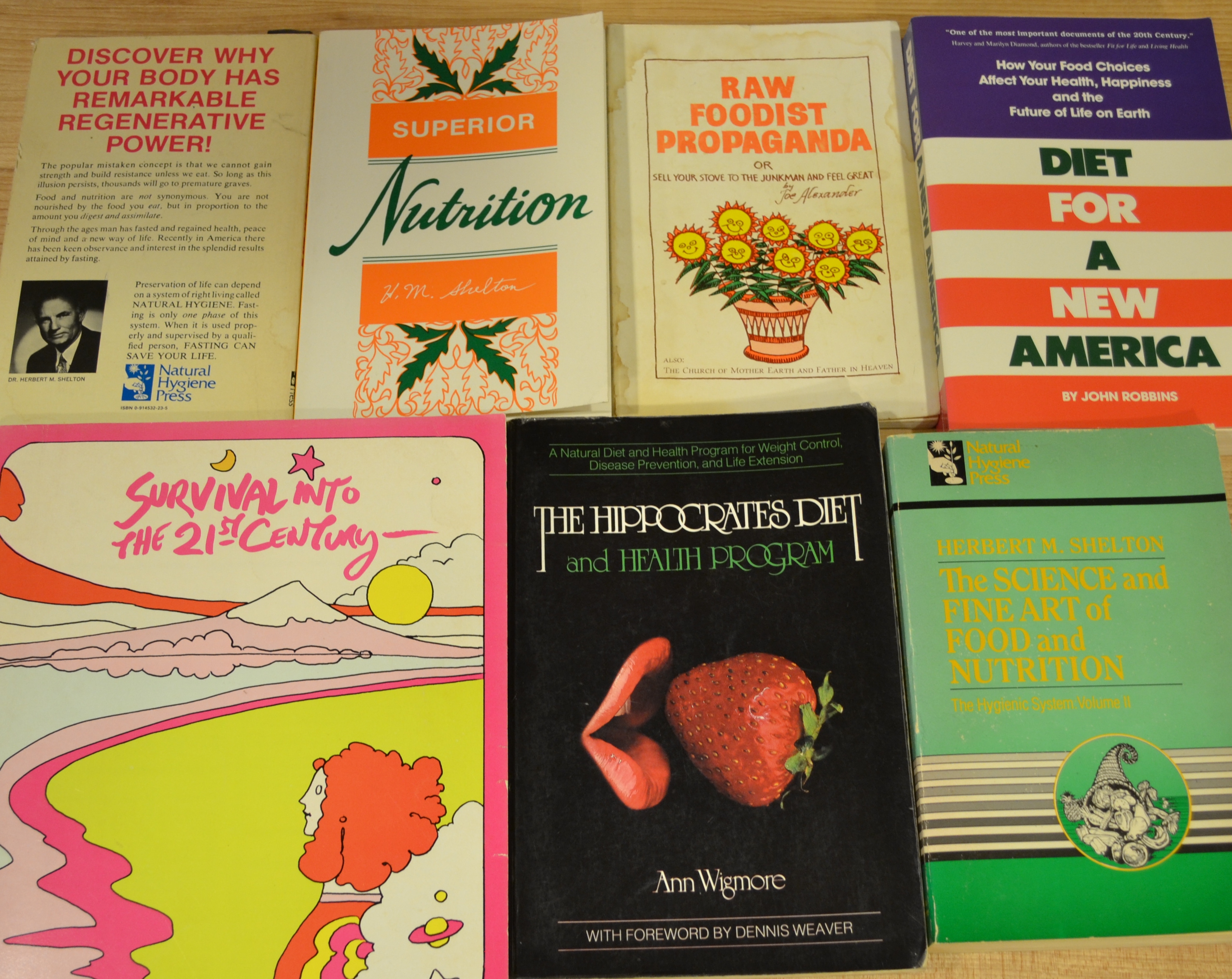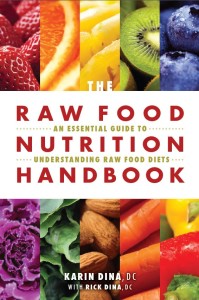It’s a cold December night here in Connecticut (just outside of New York City) with rain and ice particles tapping against my window. I’m warm inside with the heat on which is certainly a stark contrast to the temperature outside. Even where Rick and I live in northern California, winter weather can be cold at times, especially at night. We’ve even had a couple of frosts there in recent years, but we know that many of you live in much colder places, so….
It’s not surprising that one of the many questions Rick and I are asked is how to stay raw or mostly raw in the winter time, especially in a cold or very cold climate. This question is especially pertinent and the answer is one I know from my own personal experience. I started my raw food journey in February of 1990 here in the northeastern United States. Snow was on the ground, temperatures were below freezing on most days, and good quality produce was scarce. I found out rather quickly that I would need to be creative in my raw food approach, given that many of the available raw food books at the time extolled the virtues of beautiful tropical fruits that I had never heard of and the benefits of moving to a warm climate. Neither was my reality at the time, so here are some tips that made that winter of 1990 a success with raw food along with some other strategies and thoughts I have learned since then:
- Keep it simple – My first winter on raw, I focused on produce that was available in my local grocery store. There weren’t any “health food” stores that sold produce in the area where I lived so I made the best with what was available to me. Availability of raw fruits and vegetables that winter back in 1990 was much more limited than today. Fruit choices included bananas, oranges, apples, pears, grapes, dried papaya, raisins, and some others. Leafy green choices included three different types of lettuce, spinach, and other greens that I had never tried, like kale. I was so excited with how good I felt on raw that the limited variety of produce in my area did not really phase me much at all. Instead I enjoyed my adventure exploring foods that were new to me and along with different raw food preparation methods.
- Make warm dressings for salad – Back in 1990, I made dressings in my low powered blender and found that they would get somewhat warm during the process. Years later, when Rick and I purchased a high-power blender, we found that our dressings and sauces could get quite warm.
- Use of warming spices can be an option – Back in 1990, I did not use warming spices mostly because I was not yet familiar with them. Now, many of our students speak about their use of ginger, cumin, curry, turmeric, and others in their recipes.
- Warm soups in the dehydrator – I did not have a dehydrator back in 1990, but in recent years I have used our dehydrator to warm various raw soups.
- Exercise! – I think this is one of the most underutilized strategies for people trying to stay warm in cold climates. I can understand why, especially if one has to go outside to exercise in cold or extremely cold temperatures. Since I have been running regularly for several years now, winter temperatures do not seem as cold to me. I find that my hands and feet are warm throughout the winter, which makes sense, given that one of the many benefits of exercise is increased peripheral circulation.
- Check on the availability of seasonal fruits and vegetables – Seasonal fruits for late fall and early winter include some of my favorites including persimmons and pomegranates. Many varieties of leafy greens grow in California during the winter and can be found at many markets throughout the winter here in the US. Back in the winter of 1990, I had much more slim pickings in the produce department, but with growing demand for quality produce in recent decades, it is likely much easier to find better-stocked produce departments in cold climates.
- Freeze fruits gathered in summer for winter – Another strategy for having a wider variety of produce available in the winter would be gathering and freezing seasonal berries in the summer. If gathering is impractical for you or if you live in an urban area, stores like Costco and Trader Joe’s have some varieties of organic frozen fruit available year ‘round. I know that freezing may not be optimal, but this may be better than the alternatives if there is little produce availability. These frozen fruits can then be used to make smoothies or defrosted to for use in fruit salads or other recipes. In the winter, when I make a smoothie with frozen ingredients, I find myself allowing the smoothie to warm for several minutes at room temperature so it won’t be as cold when I eat it.
- Raw food does not have to be cold – When I take vegetables out of the fridge to make salad for Rick and I, by the time the salad is finished the vegetables are close to room temperature. Adding a warm blended dressing on top of the salad makes for an even warmer meal.
- At what temperature do we comfortably eat cooked food, anyway? How many times have you experienced a burning sensation on the inside of your mouth eating food that was too hot? Before I became interested in raw food, I found myself blowing on hot food in an attempt to cool it to a temperature that was comfortable to eat. Through many searches of the scientific literature over the years I’ve found that certain vitamins, phytonutrients, and enzymes start to degrade at around 104°F (40°C) and find that food warmed in a dehydrator to 104°F is comfortably warm for me. When I haven’t had access to a dehydrator, I have warmed food on the stove to 104°F on a couple of occasions. My point here is that we often find it uncomfortable to consume hot foods, so does food really have to be cooked first in order to be warming to our body? Just some food for thought 🙂 …..
One of the best ways to keep in touch with us is to join our email list. You’ll receive a free copy of Our Top 12 Strategies for Long Term Success on A Raw Plant-Based Diet eBook along with regular information about raw food and plant-based diets and periodic promotions for our classes, events, and other offerings!
What I wish I had known when I started with raw food 25 years ago

2015 is my 25 year raw food anniversary. Back in 1990, when I first learned of raw food, I could not have imagined the impact that it would have on my future life. In the beginning, I was naturally skeptical and thought that eating this way was a little extreme. Nonetheless, out of curiosity, I gave raw food a try and was surprised with the results. As my energy increased and my general health and well-being improved, my skepticism began to melt away. Looking back, I remember how I imagined the potential of raw plant food making a difference in people’s lives. I envisioned a time and place where raw food consciousness was more mainstream and that I would one day teach this valuable information to enthusiastic groups of students. Well, with a lot of work and dedication those dreams did come true and I am just as excited about raw food today as back then, with that early enthusiasm positively tempered by experience, research, and education.
The raw food world was a much smaller place back in 1990 as there weren’t nearly as many raw food resources as there are today. Back then there were a small number of raw food books and teachers, and I only knew a handful of raw food enthusiasts. This term is well-chosen since those that I knew were definitely enthused. The internet was not as we know it today and there was no social media. Finding information on raw food and plant-based diets was a bit of an adventure, and I was always happy to find books on the subject that most people would now consider classics. Given the few resources available, a lot of what I learned in those early days was through experience, and I ‘experienced’ many bumps and potholes along the way. There are so many things that I wish that someone had told me when I started with raw food back then. So here I will share with you the top five pieces of information that had I known, would have made my raw food journey smoother. I am hoping they can be of use to you:
#1: Move at your own pace. When I became interested in raw food, most of the literature I read and my social influences suggested that I had to be 100% raw right away. Transitioning was not really discussed, so I did not really see it as an option at first. Raw food seemed like an all or nothing proposition. But, I was honest with myself about what was achievable at that time. I found that I needed some time to become familiar with foods that were available in my area and how to prepare them. At the time, I was living in New England and it was winter. The fruits available were bananas, oranges, apples, pears, grapes, dried papaya spears, raisins, and a few other choices. Available leafy greens included three different types of lettuce, spinach, and other greens that I had never tried, like kale. I had a low-power blender that I used to make “smoothies” that were more lumpy than smooth. A super-enthused raw friend of mine used to call my smoothies “chunkies”.
These and other day to day considerations that one needs to address when getting started with raw food became part of my own self-stylized transition that progressed as I became more educated. Another fellow raw food enthusiast from those days went 100% raw overnight, saying that she would never eat anything cooked ever again. This lasted three months, and shortly thereafter she lost interest in healthy eating because maintaining 100% raw was too restrictive for her. All too often I see people leave raw food discouraged for this same reason.
Where am I now? Currently, I am somewhere between 90 and 100% raw and this percentage has varied over the years, depending on my situation. Percentages differ per person and I encourage you to find the percentage that works best for you. The most successful long-term raw food enthusiasts understand this idea and tend to be flexible with their approach depending on their personal needs and situation. What dietary approach gives you the results you are looking for and is sustainable right now? What approach will be sustainable long term? I have found that research, experience, and education combined were the best training, and the approach that worked best for me revealed itself in time.
#2: Gather much information from multiple points of view and sources. It is important to consider information from other points of view than your own because you may learn information not acquired if you were only looking for information supporting your current paradigm. Searching for information that supports your current point of view is referred to as confirmation bias. I have been using this term and discussing this idea in our Science of Raw Food Nutrition series of classes for years, because I think that awareness of this tendency is so important. Countless times I have learned valuable information from people with a differing point of view, and that information has made a difference in my health, my thinking, and other aspects of my life.
While we are on the subject of information, when I began my raw food journey 25 years ago, I had so many questions, most of which were not answered in the raw food literature available at the time. I was looking for more concrete answers than these books provided, so I decided that I would one day write a book that answered these questions to make the raw food journey easier for people who came after me. This book is the Raw Food Nutrition Handbook: An Essential Guide to Understanding Raw Food Diets. In this book, Dr. Rick and I cover the “where do you get your” questions, like where do you get your protein, B12, vitamin D, omega 3 fats and more. We provide updated research-based information on classic raw food topics like enzymes, food combining, and raw plant sources of important vitamins and minerals. We also discuss the different approaches to raw food and how raw food diets compare nutritionally to other dietary approaches, and much more.
#3: Know your source. Some raw food enthusiasts tend to follow one particular person’s point of view. I encourage you to educate yourself on a variety of points of view. One of the reasons why is because we all have different experiences and no one person can know everything about a subject. Very often, I have seen raw food educators change their approach as they learn more. The theme here is that we are all learning, even those of us who have been on this path for many years. The more that I learn about nutrition and how the body works, the more I realize how much I have yet to learn. Even after 25 years, I find myself asking questions and seeking answers. When the need arises, I encourage people to consult with a knowledgeable licensed healthcare provider to help with making important health-related decisions.
#4: Use critical thinking, be selectively open-minded, and enjoy the process. Critical thinking involves gathering as much information as possible about a subject, and making a decision based on that information while remaining open-minded to other information that may be learned in the future. As stated earlier, countless times I have discovered information that changed my point of view for the better. I think of researching as an ongoing and enjoyable opportunity to improve the quality of life for people in my life.
#5: Make changes if or when necessary. Here is my classic example: My introduction to raw food in 1990 was the natural hygiene approach. Nowadays, people commonly refer to this approach as various versions of LFRV, HCRV, etc. This approach worked very well for me for a while but as time went on, I refined my approach. The information I learned and the refinements and changes I made ultimately gave me the health results I was seeking.
Bonus #6: Surround yourself with a supportive community. As a long term raw food enthusiast, author, clinician, and educator, I have learned much on this path and sincerely hope this information can be of use to you. There is still much more that I have to share with you, which is why I have this blog, our YouTube channels, our book, and our classes, so I encourage you to check out these resources.
And if you are wondering, the super-enthused raw friend that used to call my smoothies “chunkies” is now my husband, Dr. Rick Dina. Back when we got started with healthy eating, our support system was our group of friends which made all the difference in that we helped each other to stay on track, shared our experiences and research, discussed changes and refinements, challenged raw food dogma, and had a lot of fun! We wish you the best in your journey and invite you to share in ours.
One of the best ways to keep in touch with us is to join our email list. You’ll receive a free copy of Our Top 12 Strategies for Long Term Success on A Raw Plant-Based Diet eBook along with regular information about raw food and plant-based diets and periodic promotions for our classes, events, and other offerings!


